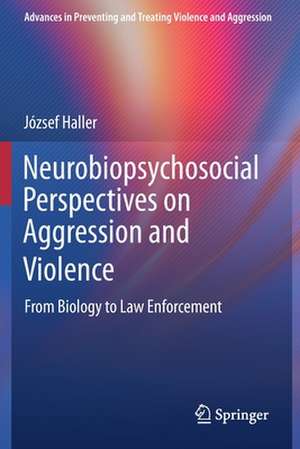Neurobiopsychosocial Perspectives on Aggression and Violence: From Biology to Law Enforcement: Advances in Preventing and Treating Violence and Aggression
Autor József Halleren Limba Engleză Paperback – 11 sep 2021
Topics featured in this book include:
- The heritability of aggressiveness and violence-proneness.
- Glucocorticoids in humans.
- Aggression circuitry in animals.
- Distorted circuitry in violent animals.
- Biological factors of psychological change.
| Toate formatele și edițiile | Preț | Express |
|---|---|---|
| Paperback (1) | 784.30 lei 6-8 săpt. | |
| Springer International Publishing – 11 sep 2021 | 784.30 lei 6-8 săpt. | |
| Hardback (1) | 790.46 lei 6-8 săpt. | |
| Springer International Publishing – 11 sep 2020 | 790.46 lei 6-8 săpt. |
Preț: 784.30 lei
Preț vechi: 956.46 lei
-18% Nou
Puncte Express: 1176
Preț estimativ în valută:
150.07€ • 157.11$ • 124.18£
150.07€ • 157.11$ • 124.18£
Carte tipărită la comandă
Livrare economică 05-19 aprilie
Preluare comenzi: 021 569.72.76
Specificații
ISBN-13: 9783030463335
ISBN-10: 3030463338
Ilustrații: XI, 351 p. 32 illus., 26 illus. in color.
Dimensiuni: 155 x 235 mm
Greutate: 0.51 kg
Ediția:1st ed. 2020
Editura: Springer International Publishing
Colecția Springer
Seria Advances in Preventing and Treating Violence and Aggression
Locul publicării:Cham, Switzerland
ISBN-10: 3030463338
Ilustrații: XI, 351 p. 32 illus., 26 illus. in color.
Dimensiuni: 155 x 235 mm
Greutate: 0.51 kg
Ediția:1st ed. 2020
Editura: Springer International Publishing
Colecția Springer
Seria Advances in Preventing and Treating Violence and Aggression
Locul publicării:Cham, Switzerland
Cuprins
Chapter 1. Dissecting the concept of aggression from biology to law enforcement.- Chapter 2. The heritability of aggressiveness and violence-proneness.- Chapter 3. Neurogenetics, genome-wide association and candidate gene studies.- Chapter 4. Social factors of biological change.- Chapter 5. The biology of glucocorticoids – normal and abnormal aggression.- Chapter 6. Glucocorticoids in humans.- Chapter 7. The aggression circuitry in animals.- Chapter 8. Distorted circuitry in violent animals.- Chapter 9. The neurobiology of human aggression and violence.- Chapter 10. Biological factors of psychological change.
Notă biografică
József Haller, Ph.D., DSc, studied the neurobiology of aggression for most of his scientific career. He published more than 150 articles in peer-reviewed scientific journals and authored three books on the subject. His last book was Neurobiological Bases of Aggression and Violent Behavior (Springer, 2014). As a leader of the Behavioral Neurobiology Department of the Institute of Experimental Medicine, Budapest, Hungary, he contributed to aggression research by initiating the concept of abnormal aggression in animals, developing two laboratory models of aggression-related psychopathologies, and differentiating the neurobiological bases of normal manifestations of aggression from those of its abnormal forms and violence. His scientific work is widely known and cited in the field. He was recently appointed the head of the Institute of Behavioral Sciences and Law Enforcement, University of Public Service, Budapest, Hungary, where he teaches criminal psychology and conducts research in this field.
Textul de pe ultima copertă
This book bridges the gap between basic science, which deals with general concepts of aggression and its neurobiological foundations, and law enforcement as one of the applied fields of aggression research. It addresses the current state of research and practice and compares and integrates the concept of aggression with violent crime. Chapters examine the types of criminal careers that cross the boundary between the two and summarize the biological, psychological, and social factors that underlie particular types of criminal careers. Subsequent chapters discuss overlaps between biological and psychological factors and detail how and to what extent aggression may serve as explanatory mechanisms for violence. The book also discusses the relationship between social problems and neuropsychological deficits, addressing how the neuropsychological deficits lead to the intergenerational recycling of social problems. Finally, the volume explores violence and aggression from a neurobiological perspective.
Topics featured in this book include:
- The heritability of aggressiveness and violence-proneness.
- Glucocorticoids in humans.
- Aggression circuitry in animals.
- Distorted circuitry in violent animals.
- Biological factors of psychological change.
Caracteristici
Bridges gaps between neurobiological research of violence and aggression and applied practices of law enforcement Synthesizes biological, psychological, and social factors underlying specific types of criminal careers Examines overlaps between biological and psychological factors underlying aggression and violence Addresses ways in which neuropsychological deficits lead to intergenerational recycling of social problems






